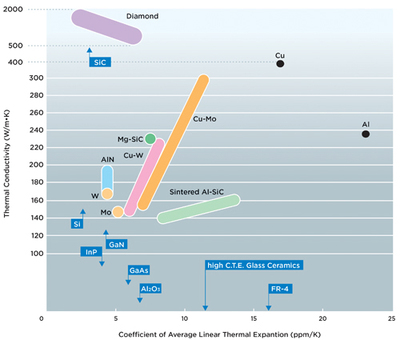Pos:
Home KnowledgeTechnology Diamond wafers assist in heat dissipation of high-power semiconductor lasersDuring operation, high-power semiconductor lasers generate a significant amount of heat per unit area due to the extremely high light power released by each chip. If heat dissipation technology is not effectively utilized, the chip may suffer serious damage and its performance will rapidly decline. In addition, thermal efficiency has a significant impact on the performance of lasers. It not only reduces the output power and electro-optical conversion efficiency of lasers, but may also shorten the service life of lasers and even lead to complete failure. Therefore, for the packaging of high-power semiconductor lasers, the selection of transition heat sink is crucial.
In the design of transition heat sinks, we mainly focus on two core requirements: low thermal resistance and low heat mismatch. A transition heat sink with higher thermal conductivity can effectively reduce the thermal resistance of the laser, thereby improving its heat dissipation performance. At the same time, we also need to carefully consider the matching problem of thermal expansion coefficient between the chip and the heat sink. To ensure good thermal matching, we need to select appropriate sintered solder according to specific needs to minimize thermal mismatch. In this way, we can further improve the output characteristics of high-power semiconductor lasers, ensuring their stable and efficient operation.
Diamond, as a high-power semiconductor laser packaging heat sink, exhibits excellent heat dissipation characteristics: on the one hand, it can uniformly and quickly diffuse the heat concentrated on the PN junction of the device along the surface of the heat sink; On the other hand, heat is rapidly exported along the vertical direction of the heat sink. Therefore, diamond film can be applied to produce heat sink materials for high-power optoelectronic components.
With the rapid development of diamond manufacturing technology, the cost of diamond has been reduced, making it widely used. At present, the thermal conductivity of artificial diamond heat sinks has reached over 2000W/(K · m), far greater than the thermal conductivity of aluminum nitride and copper. Diamond heat sinks with high thermal conductivity have significant advantages as transitional heat sinks.

CSMH focuses on the research and development, production, and sales of diamond materials. Its core products include diamond wafers, diamond heat sinks, diamond windows, and diamond hetero-integrated composite substrates. Among them, the surface roughness of the diamond wafer Ra<1nm; The thermal conductivity of diamond heat sinks can reach 1000-2000W/(m.K). At present, diamond heat sinks are applied in high-power semiconductor lasers, drones, aerospace, radar, new energy vehicle IGBTs and other fields.
 闽ICP备2021005558号-1
闽ICP备2021005558号-1Leave A Message